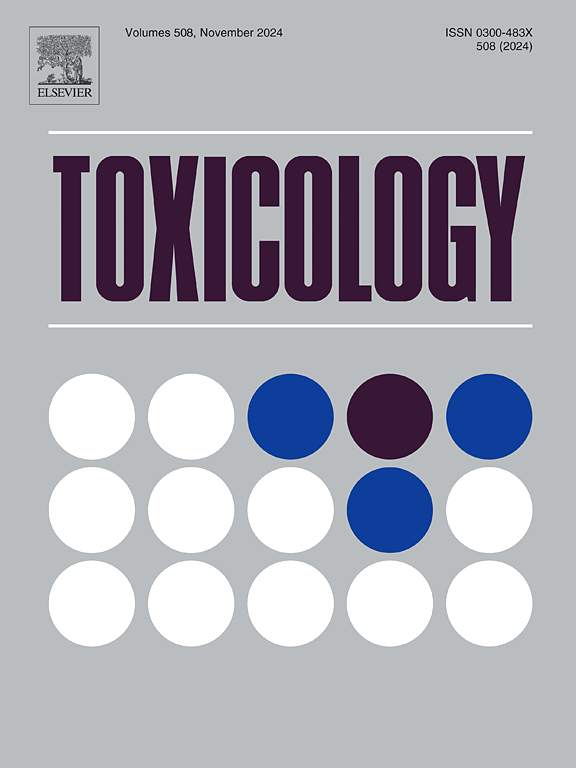Synergistic effects of lead and copper co-exposure on promoting oxidative stress and apoptosis in the neuronal cells
IF 4.8
3区 医学
Q1 PHARMACOLOGY & PHARMACY
引用次数: 0
Abstract
Exposure to lead (Pb) or copper (Cu) is common and has been associated with increased risk of neurodegenerative disease. However, combined neurotoxic effects of co-exposure to these elements remain unclear. This study aimed to determine the toxic effects of Pb and Cu co-exposure on HT22 cells. In this study, Pb and Cu co-exposure exhibited enhanced toxicity, including increased reactive oxygen species (ROS) and Malondialdehyde (MDA) levels, Superoxide Dismutase 1 (SOD1) activity, lower cell viability and higher apoptotic rates, compared to single-element exposure. Pb and Cu co-exposure also resulted in significantly increased cellular labile Cu level by altering the protein levels of Cu transporters, including Copper Transporter-1 (CTR1), ATPase Copper Transporting-α(ATP7A) and ATPase Copper Transporting-β (ATP7B). Treating with antioxidants or Cu chelator to the co-exposed cells blocked the reduction cell viability and elevation of apoptotic rates. This study suggests that Pb and Cu co-exposure can result in a synergistic toxicity in neuronal cells by inducing oxidative stress and apoptosis. The cellular Cu accumulation may play an important role in inducing these synergistic effects, and both antioxidation and Cu chelation may be promising control measures to alleviate the neurotoxicity of Pb and Cu co-exposure.
铅和铜共暴露对促进神经细胞氧化应激和凋亡的协同作用
接触铅(Pb)或铜(Cu)是常见的,并且与神经退行性疾病的风险增加有关。然而,共同暴露于这些元素的综合神经毒性作用仍不清楚。本研究旨在确定铅和铜共暴露对HT22细胞的毒性作用。在这项研究中,与单一元素暴露相比,Pb和Cu共暴露表现出增强的毒性,包括活性氧(ROS)和丙二醛(MDA)水平升高、超氧化物歧化酶1 (SOD1)活性升高、细胞活力降低和凋亡率升高。Pb和Cu共暴露还通过改变铜转运蛋白(Copper Transporter-1, CTR1)、ATPase Copper transporter -α(ATP7A)和ATPase Copper transporter -β (ATP7B))的蛋白水平,导致细胞内不稳定铜水平显著升高。用抗氧化剂或铜螯合剂处理共暴露细胞可阻断细胞活力的降低和凋亡率的升高。本研究提示,铅和铜共暴露可通过诱导氧化应激和细胞凋亡而对神经细胞产生协同毒性。细胞内的Cu积累可能在诱导这些协同效应中起重要作用,抗氧化和Cu螯合可能是减轻Pb和Cu共暴露神经毒性的有希望的控制措施。
本文章由计算机程序翻译,如有差异,请以英文原文为准。
求助全文
约1分钟内获得全文
求助全文
来源期刊

Toxicology
医学-毒理学
CiteScore
7.80
自引率
4.40%
发文量
222
审稿时长
23 days
期刊介绍:
Toxicology is an international, peer-reviewed journal that publishes only the highest quality original scientific research and critical reviews describing hypothesis-based investigations into mechanisms of toxicity associated with exposures to xenobiotic chemicals, particularly as it relates to human health. In this respect "mechanisms" is defined on both the macro (e.g. physiological, biological, kinetic, species, sex, etc.) and molecular (genomic, transcriptomic, metabolic, etc.) scale. Emphasis is placed on findings that identify novel hazards and that can be extrapolated to exposures and mechanisms that are relevant to estimating human risk. Toxicology also publishes brief communications, personal commentaries and opinion articles, as well as concise expert reviews on contemporary topics. All research and review articles published in Toxicology are subject to rigorous peer review. Authors are asked to contact the Editor-in-Chief prior to submitting review articles or commentaries for consideration for publication in Toxicology.
 求助内容:
求助内容: 应助结果提醒方式:
应助结果提醒方式:


